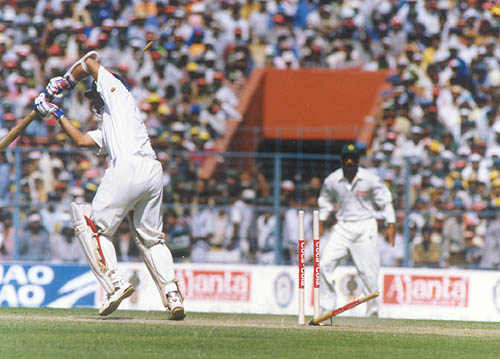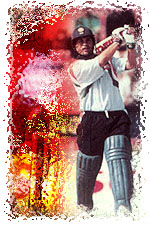Heavy bat may be Sachin's burden
 Sachin Tendulkar's
well-documented back injury may not be serious. But there is no
mistaking the wake-up call. In the days ahead, he will be forced
to do some hurried rethink in continuing with an ultra-heavy bat,
the physical effects of which is evident from the first
disturbing signs of wear and tear from a decade-long cricketing
grind.
Sachin Tendulkar's
well-documented back injury may not be serious. But there is no
mistaking the wake-up call. In the days ahead, he will be forced
to do some hurried rethink in continuing with an ultra-heavy bat,
the physical effects of which is evident from the first
disturbing signs of wear and tear from a decade-long cricketing
grind.
Tendulkar, now 25, has been playing
international class bowlers from an age when others the same age
were still playing school and gully cricket. At that time, his
body was not fully developed to cope with the physical demands at
the international level.
Tendulkar stood out from the crowd very early
in his career by preferring a very heavy bat. His willow weighs
an elephantine 3lbs, 2 ounces which he had scaled down to 2lbs,
12 ounces for a time. With more wood at the bottom and three
grips adding to the load, the strain on his wrists and back is
enormous.
Most batsmen are in the comfort zone with much
lighter bats. Someone like Brian Lara prefers abat weighing 2lbs,
4ozs. Only batsmen like Clive Lloyd and Lance Cairns used bats
that came in the range of Tendulkar's unusual willow weight. But
both Lloyd and Cairns were huge, almost a foot taller than
Tendulkar, and blessed with far greater muscle mass.
But Tendulkar loves the additional weight to
facilitate his punches to the straight field – those
seemingly defensive blocks with minimum backlift which streak
past the bowler to the fence. It's also his ally while executing
the on-the-rise essays. But Tendulkar plays all the strokes in
the book and some are patently his own. The damage is done when
he `tees off', lofting bowlers in the arc between long-on and
long off, with the follow through of the bat finishing behind the
back, and while playing the cuts and pulls. Says former India
seamer and ex-Mumbai Ranji coach Balwinder Sandhu: ``The heavy
bat could be one possible explanation why Sachin has not gone on
to score a double hundred at international level. Heavy bats
cause tiredness. And withtiredness, the bat speed diminishes and
mistakes creep into the game. Maybe, he should switch to a
lighter bat. But that is something only he can decide.''
Tendulkar himself once said: ``To me, the shape
(of the bat) is very important. The bat must be thick and have
more meat near the bottom. There should be a rounded kind of
blade. I don't like a slim, flat blade. I want power in my shots,
so the bat should be thick and strong.''
Says Raju Mehta, a former Baroda Ranji Trophy
player and Sunil Gavaskar's partner in Sunny Sports Boutique: ``I
don't think anybody in contemporary international cricket is
using a bat as heavy as Sachin's. I feel that for a person of
Sachin's physique, a bat weight around 2lbs, 8 ounces would be
ideal the same that Sunil batted with for most of his career.''
While the rules are clear about the weight of
the ball (not less than 52 ounces 155/9g nor more than 53
ounces/163g), there is no statutory weight for bats. In fact,
till Dennis Lillee garnered humongous publicity bycoming in to
bat with an aluminium bat in the 1979-80 Ashes series, the laws
were silent on even the composition of the bat.
Makarand Waingankar, who was the coordinator of
the now defunct BCA-Mafatlal Bowling Scheme, recollects Frank
Tyson warning Indian youngsters against the use of heavy bats.
The former England paceman, now a famed coach, believed that the
Indian physique was not conducive to take the load of such bats.
Dr Dilip Nadkarni, one of the leading sports
medicine and orthopaedic surgeons of the country, says: ``If the
bat is very heavy and the swing is very long (full follow
through), a large amount of force is generated on the lower back.
This force has to be countered by the back for the stroke to be
completed effectively. If the muscle strength falls short of the
force generated by the bat and the swing, there could be micro
tear of the muscles or the forces could be transmitted to the
joints of the lower back and could cause injury to the the
intervertebral discs, leading to serious backproblems.''
One advantage, Dr Nadkarni felt, was that being
a short person (5feet, four inches), Tendulkar's lever arm is
short, thereby minimising the chances of a severe injury. He felt
that a lighter bat would reduce the chances of a spinal injury,
while a heavier bat could be a source of aggravation.
The research and development emphasis of modern
technology has been towards performance-enhancement. At the same
time, sporting equipment has become increasingly lighter. In
tennis, rallies have got shorter with the passage of time as
graphite and kevlar racquets have done wonders in generating
power. These racquets are much, much lighter than the wooden ones
and absorb much of the shock of the ball contacting with the
racquet.
 Tendulkar himself wears moulded polystyrene pads which
are feather-light. Cricket has changed so much that modern
batsmen wear a lot more equipment than his predecessors did in
the '50s and '60s. Today's batsmen have the added weight of the
helmet and grills, thigh pads, forearmprotectors, chest and shin
guards.
Tendulkar himself wears moulded polystyrene pads which
are feather-light. Cricket has changed so much that modern
batsmen wear a lot more equipment than his predecessors did in
the '50s and '60s. Today's batsmen have the added weight of the
helmet and grills, thigh pads, forearmprotectors, chest and shin
guards.
Sir Don Bradman records in his epic, The Art of
Cricket: ``I started my Test career with a full-size bat but
changed later to a short handle which I used for the greater part
of my career. My height is about five feet eight inches and I
found the full-length handle slightly cumbersome for my build and
strokeplay.''
Medical experts believe that as the body ages,
the water content in the nucleus of the intervertebral discs
begin to decrease. By the late 20s, it would have dropped about
15 per cent. As a result, ageing discs have less ability to
withstand compressed forces and rebound to their normal sizes
after compression.
Medical opinions also point out that backaches
rank second to headaches as the most frequent type of physical
pain -- an ailment that is usually caused by trauma, from
abnormal lifting of weights, from muscle fatigue or from a
congenital problem. Many a career has ended because of back
problems. Batsmen are less susceptible than fast bowlers,
butthere are exceptions.
Remember, the case of Bob Woolmer?
Tendulkar's longevity in international cricket
may best be served by opting for a lighter bat now when he is
touching 30 -- by which time, the damage may be far more severe
or even beyond redemption. Maybe, there is a lesson for Tendulkar
in Sir Don's example besides medical reasoning.
 Sachin Tendulkar's
well-documented back injury may not be serious. But there is no
mistaking the wake-up call. In the days ahead, he will be forced
to do some hurried rethink in continuing with an ultra-heavy bat,
the physical effects of which is evident from the first
disturbing signs of wear and tear from a decade-long cricketing
grind.
Sachin Tendulkar's
well-documented back injury may not be serious. But there is no
mistaking the wake-up call. In the days ahead, he will be forced
to do some hurried rethink in continuing with an ultra-heavy bat,
the physical effects of which is evident from the first
disturbing signs of wear and tear from a decade-long cricketing
grind.  Tendulkar himself wears moulded polystyrene pads which
are feather-light. Cricket has changed so much that modern
batsmen wear a lot more equipment than his predecessors did in
the '50s and '60s. Today's batsmen have the added weight of the
helmet and grills, thigh pads, forearmprotectors, chest and shin
guards.
Tendulkar himself wears moulded polystyrene pads which
are feather-light. Cricket has changed so much that modern
batsmen wear a lot more equipment than his predecessors did in
the '50s and '60s. Today's batsmen have the added weight of the
helmet and grills, thigh pads, forearmprotectors, chest and shin
guards.